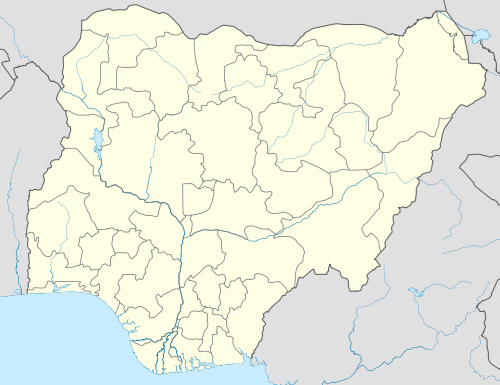Makoko
| Makoko | |
|---|---|
| Informal Settlement | |
 Makoko | |
| Coordinates: 6°29′44″N 3°23′39″E / 6.49556°N 3.39417°ECoordinates: 6°29′44″N 3°23′39″E / 6.49556°N 3.39417°E | |
| Country | Nigeria |
| State | Lagos State |
| LGA | Lagos Mainland |
| Location | Makoko |
| Settled | 18th century |
| Population (2012) | |
| • Total | 85,840 |
Makoko is a slum neighbourhood located in Lagos. The community, which initially was founded as a fishing village, eventually developed into a slum as a result of population explosion.[1][2] In July 2012, Nigerian government officials destroyed dozens of residences in the area. The destruction of this historic community was in order to redevelop what is now seen as prime waterfront.[3]
History

Established in the 18th century primarily as a fishing village, much of Makoko rests in structures constructed on stilts above Lagos Lagoon.[1][2] As of 2006, the area is essentially self-governing with a very limited government presence in the community and local security being provided by area boys.[4] In July 2012, Nigerian government officials destroyed dozens of residences after giving residents 72 hours notice of eviction. The destruction of this historic community was in order to redevelop what is now seen as prime waterfront. Nearly 3,000 people had been rendered homeless.[3][5][6][7] Two months after the partial demolition, a Serac housing affiliate known as the Urban Spaces Innovation developed a regeneration plan for Makoko that would bring the community together with academics, non-profits, and international consultants. The plan was submitted to the Lagos State Ministry of Urban and Physical Planning in January 2014.[7]
Makoko is home to the Makoko Floating School. Designed by Nigerian architect Kunlé Adeyemi in collaboration with the Makoko Waterfront Community, the three-story high building was completed in March 2013. The school has received global recognition, including the Design Museum's Design of the Year Award. On 20 April 2015, the Lagos State Ministry of Physical Planning and Urban Development announced that the school may be incorporated into a regeneration plan for the entire Makoko community.[8]
Makoko is sometimes referred to as the "Venice of Africa".[9] Its population is considered to be 85,840; however, the area was not officially counted as part of the 2007 census and the population has been estimated to be much higher.[1]
See also
References
- 1 2 3 This Day (1 May 2009). "Makoko Residents And Their Unwanted Guest". Africa News.
- 1 2 Cohen, Roger (20 July 1998). "Nigerian Slum's Filth Is a World Away From Capital's Glitter". The New York Times.
- 1 2 "Destroying Makoko". The Economist. 18 August 2012.
- ↑ UN Integrated Regional Information Networks (5 September 2006). "Lagos, the Mega-City of Slums". Africa News.
- ↑ "Lagos Makoko slums knocked down in Nigeria". BBC. 17 July 2012. Retrieved 28 February 2015.
- ↑ "Nigeria: Day After Makoko and Abonema - Frustration of a Homeless Nation". allAfrica.com. Retrieved 28 February 2015.
- 1 2 Tolu Ogunlesi, "Inside Makoko: danger and ingenuity in the world's biggest floating slum", The Guardian, 23 February 2016.
- ↑ Jessica Collins, "Makoko Floating School, beacon of hope for the Lagos 'waterworld' – a history of cities in 50 buildings, day 48", The Guardian, 2 June 2015.
- ↑ Soni Methu (24 December 2014). "Postcards from home: documenting Nigeria's floating community". CNN. Retrieved October 10, 2015.
External links
| Wikimedia Commons has media related to Makoko. |
- Iwan Baan (26 May 2013). "School at Sea". New York Times. Photos of Makoko.
Images
.jpg)
 Detail of map of Lagos, 1962, showing Makoko and Lagos Mainland
Detail of map of Lagos, 1962, showing Makoko and Lagos Mainland.jpg)
.jpg)
 Makoko, 2010
Makoko, 2010